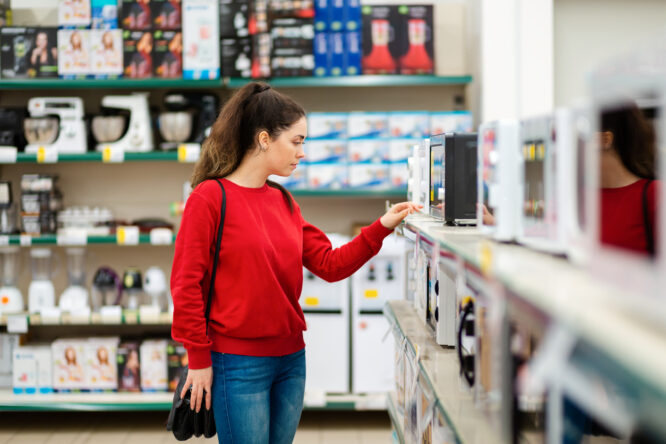Ever bought something and later wondered, “Why did I even want that?”

You’re definitely not alone. Brands are masters at using psychology to influence your choices, often without you even noticing. Many companies literally have entire departments dedicated to the latest research into ways to convince customers they need to buy their products ASAP. Here are some of their secrets—once you know about them, you might find they’re slightly less effective (hopefully, anyway).
1. They anchor your expectations with higher prices first.

When you see a luxury item listed for £500, and then another for £150, that second option suddenly seems like a bargain, even if it’s still overpriced. This is called “anchoring,” and it’s a way of planting a high number in your mind so everything else feels more reasonable in comparison. You weren’t going to buy the £500 thing anyway, but now the £150 one looks downright sensible.
This trick shows up everywhere, from restaurants to online stores. The first thing you see is rarely the one you’re meant to buy. It’s just there to make the next option look more appealing. Once your brain latches onto that anchor price, it starts adjusting everything else around it, even if you’re not consciously aware it’s happening.
2. They create false urgency to trigger impulse decisions.

“Limited stock available!” “Ends tonight!” “Someone in Glasgow just bought this!” These tricks are all about making you feel like you’ll miss out if you don’t act now. It taps into your fear of regret, creating a sense of urgency that can override your usual decision-making process. Suddenly, it feels less like shopping and more like a race.
These countdown timers and “low stock” warnings don’t always reflect reality. Sometimes, they’re just tactics to nudge you over the edge. When you feel rushed, you’re far less likely to take a step back and ask, “Do I really need this?” And that’s exactly what they’re counting on.
3. They use your identity to influence your choices.

Brands love to sell you a version of yourself, not just a product. Are you someone who’s smart, stylish, eco-conscious, or bold? Great, because they’ve got something that matches exactly that. When marketing speaks directly to who you think you are (or who you want to be), it feels personal, and harder to resist.
It’s not always manipulative, but it’s powerful. When something feels like it’s made “just for you,” you’re far more likely to justify the purchase. It has nothing to do with whether you need it; it’s whether it fits the image you’ve bought into. The more connected you feel to the brand’s identity, the more you’re willing to spend to align with it.
4. They play with colours and store layouts to guide your choices.

There’s a reason sale signs are usually red, and clearance sections are tucked away at the back of the store. Brands use colour psychology and space design to direct your attention and influence how long you browse. Warmer colours signal urgency, while cooler tones can create a sense of calm and luxury, each vibe perfectly suited to different shopping goals.
Even the way aisles flow or how items are placed at eye level isn’t random. You’re more likely to buy things you don’t need if you have to walk past them to get what you came for. The layout is built to slow you down, distract you, and tempt you, all while making it feel like you’re just “browsing.”
5. They offer “free” perks that make you spend more.

Free shipping if you spend over £50? A gift with your purchase? These offers seem generous, but they’re designed to get you to increase your basket total. Psychologically, we’re wired to maximise value, so if you’re close to the free shipping threshold, you’re likely to add another item just to reach it, even if you don’t actually want it.
These perks make spending more feel like a smart move, even though the brand is the one coming out on top. It’s a nudge that frames spending as saving, and most of us fall for it more often than we’d like to admit.
6. They rely on social proof to build trust fast.

Ever seen a product with thousands of glowing reviews, or been told it’s the “most popular item” right now? That’s social proof at work. We’re more likely to buy something if we think other people already love it, especially if we’re unsure. The logic goes, “If that many people are into it, it must be good.”
Of course, social proof can be manipulated. Reviews can be curated, stars can be inflated, and popularity claims might not reflect reality. Still, our brains often don’t question it. We take shortcuts in decision-making to save time, and brands know exactly how to exploit that moment of trust.
7. They personalise your experience to reduce hesitation.

From showing you recently viewed items to sending “we thought you might like this” emails, personalisation makes you feel seen. That feeling creates a sense of comfort, and it also makes you more likely to buy. When a site feels like it “knows” you, your defences drop just a little more.
It also creates the illusion of effort. If something feels tailored to you, it feels more valuable, even if the only thing that changed was your name at the top of the email. It’s all about making the path to purchase as smooth and friction-free as possible.
8. They frame spending as self-care or empowerment.

“You deserve this.” “Treat yourself.” “Invest in your glow-up.” These kinds of messages turn purchases into emotional decisions. Brands often package their products as part of your personal growth, wellness, or empowerment journey, which makes it harder to say no without feeling like you’re letting yourself down.
It’s clever because it links consumption with self-worth. The idea becomes: if you don’t buy this thing, are you really looking after yourself? It makes normal spending feel noble, and that emotional halo can lead to bigger, more frequent purchases, all in the name of “self-love.”
9. They use scarcity to make things feel exclusive.
 Source: Unsplash
Source: Unsplash Limited editions, one-day drops, or “only a few left in stock” tricks all play on scarcity. When something feels rare or exclusive, we want it more. Our brains interpret scarcity as value, even when we didn’t want the thing in the first place.
This taps into a deep fear of missing out. The item suddenly feels like an opportunity, not just a product. Even if we didn’t plan to spend money, we convince ourselves that this could be our *only* chance to get it. That urgency short-circuits our logic and ramps up emotional spending fast.
10. They reward loyalty in ways that keep you hooked.
 Source: Unsplash
Source: Unsplash Loyalty schemes, reward points, and member-only sales sound like perks, but they’re also designed to keep you coming back. When you feel like you’re “earning” something with every purchase, it’s easier to justify spending. You tell yourself it’s worth it because you’re building up to a reward, even if it takes a lot of spending to get there.
These systems work because they gamify shopping. The more you spend, the more points you get, and that progress can be weirdly addictive. It turns consumption into a goal, and once you’re invested, it feels harder to walk away, even when you know it’s just another marketing trick.




